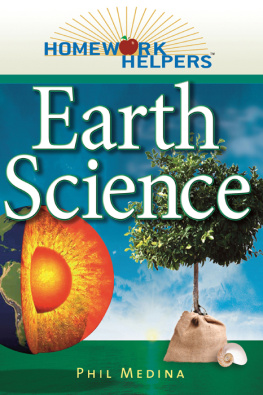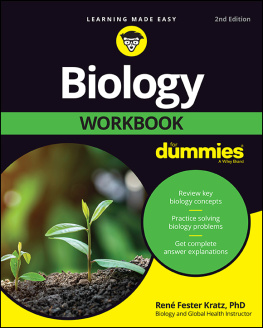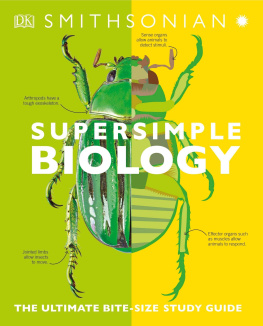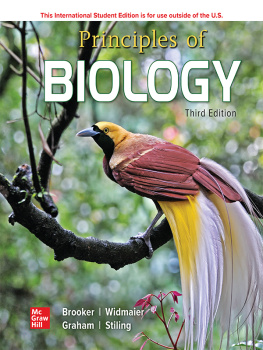Acknowledgments
To Greg Curran for giving me the opportunity to be part of this book project and for the many insights he has provided me over my years of teaching.
To Jessica Faust whose patience and drive has made the idea for this book become a reality.
To my wife, Shawn, and my children, Amanda and Luke, for all the time and support they provided to me towards the completion of this book.
To my mom for all the help with Amanda and Luke she provided during the creation of this book.
To Mike Curtain and Jeff Butkowski for providing all the computer and tech support needed on this project.
To Laura Prevatali and John Distefano for all the artwork featured in this project.
To the faculty members of the Fordham Preparatory School, who have been role models of good teaching, for their constant display of the passion needed to be successful in this profession.
1 Studying Biology
In this opening chapter, you will be introduced to the subject of biology, and you will learn how to think like a scientist and about the many tools scientists use. Biology is the study of life, and so this chapter concludes with some discussion about what life is and how living things are identified.
Lesson 1-1: Thinking Like a Scientist
In order to study biology, one must learn something of the skills of the biologist. It just happens that one of the most important skills that scientists have is something that most young children practice on a regular basis: the act of questioning. Progress in the field of biology depends on people who ask questions about the living world around them and take time to test these questions. Why is human blood red? Why do elephants have long ivory tusks? Why are most plants green? To answer questions about life, many approaches are possible. But there are steps that are common to almost all of theses approaches. These common procedures that biologists use to gather information in order to answer questions is called the scientific method. The scientific method can be looked at as an organized way of solving a problem. When using the scientific method you will follow certain steps in order to try to solve or explain unknowns in biology.
Steps of the Scientific Method
1. Recognizing a problem or something that needs to be solved.
2. Researching anything that may be known about the problem.
3. Proposing a possible answer, sometimes called a hypothesis, that could be a solution to the problem. A hypothesis must be testable by experimentation to be valid.
4. Conducting an experiment to test the proposed hypothesis to the problem.
5. Collecting and analyzing data from the experiment that will help to determine if the hypothesis is correct or incorrect.
6. Verifying if the hypothesis you stated is supported or refuted by the data from the experiment.
7. Making sure the experiment you conducted can be done again with the same results.
8. Sharing the results of the experiment with others.
The following is an example of a problem solved using the steps of the scientific method:
Example
1. Problem or unknown.
A gardener buys two fertilizers for his tomato plants (fertilizer A and fertilizer B). This gardener wants to know which fertilizer will make his tomato plants produce more fruit.
2. Researching what is known about the problem.
The gardener reads the labels of each fertilizer and tries to find any information he can on the Internet about these two brands of fertilizer.
3. Proposing a possible answer (hypothesis).
The gardener decides that fertilizer A will probably work better based on the research he has done on the two products.
4. Conducting an experiment for a possible solution to the problem.
The gardener uses fertilizer A on five of his tomato plants and fertilizer B and the other five tomato plants he has in the garden. He also grows five plants with no fertilizer at all. The gardener is careful to treat the 15 tomato plants in the same manner (watering, exposure to sunlight, soil), except for the use of the different fertilizers in the first two groups. The fertilizer used in each part of the experiment would be called the variable because it is the part of the experiment that is being questioned or studied. The five tomato plants not being given the fertilizer act as a control group. The control group acts as the basis of comparison for the variable being tested in the experiment.
5. Collecting and analyzing data from the experiment.
After a two-week period, the gardener checks the amount of fruit on the 15 plants in the study. Because the gardener is counting the number of fruit on each plant, this is considered quantitative data. Quantitative data is information that involves numbers. Data that would not involve numbers, but instead involves such things as a description, is called qualitative data. The results show that the five plants grown with fertilizer B have almost twice as much fruit as the five plants grown with fertilizer A. The 5 plants grown without any fertilizer have the least amount of fruit.
6. Drawing conclusions based on the data collected and analyzed.
The gardener saw that his initial hypothesis that fertilizer A would work better to produce more fruit than fertilizer B was wrong. Even though his hypothesis was wrong, the gardener learned valuable information that he can now apply to the success of his garden.
7. Making sure the experiment and results are repeatable.
The gardener tested these two fertilizers on five plants each within the garden, and all showed that fertilizer B produced more fruit than fertilizer A.
8. Sharing the results with others.
The gardener showed all his friends who grew tomatoes the wonderful results he had obtained in his garden with the use of fertilizer B.
As demonstrated in the example, the scientific method is an organized approach to solving a problem. Most people do it all the time in everyday situations of life, without even being aware they are performing these procedures. I will give another example to prove my point. When you cross a busy street you are unconsciously performing the steps of the scientific method. When you arrive at the curb of the street that you must cross, you are faced with the problem: I must get across this street without getting hit by a car. Your brain quickly recalls other times you have crossed a street and the steps you took to accomplish this task. You then propose a possible answer to this problem, namely how quickly you will have to walk and at what precise time, in order to reach the other curb safely. In order to propose a hypothesis about how to cross the street safely, you would collect information about the street and where the cars were coming fromfrom what direction and their speeds. The experiment would involve you actually walking across the street. Your hypothesis about how to cross the street safely would be proven correct if you got to the other side of the street safely. If you did not get across the street safely, your hypothesis would be incorrect. And just like in any biology experiment, an experiment that proves a hypothesis wrong can be used to collect as much information about the problem as an experiment that proves the hypothesis correct. Though, in this particular case, if your educated guess about how to cross the street is wrong, you may be considering a new hypothesis in the hospital!
It is important to understand that doing an experiment cannot always test a particular question that is asked about something in biology. Some problems can only be observed and possibly solved by doing what is called






